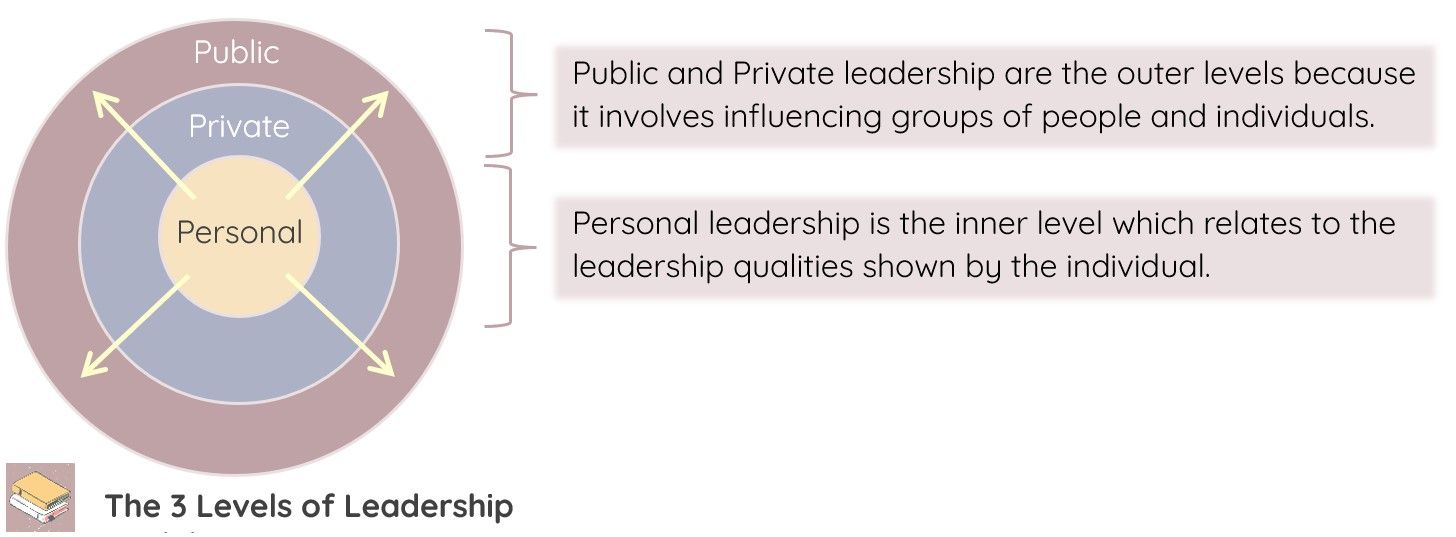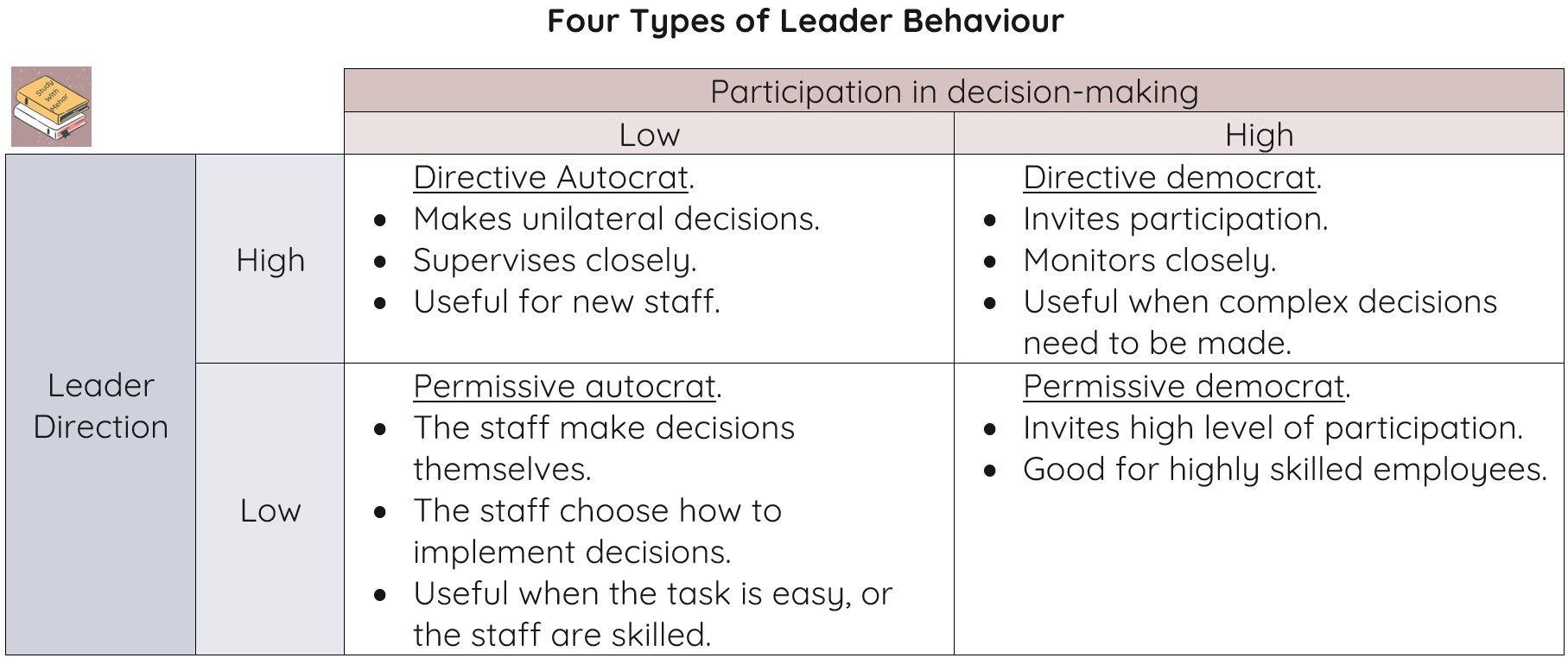9.2 Leadership & Management
Index:
Traditional and Modern Theories of Leadership
1. Universalist and Behaviouralist theories
Universalist theories of leadership look at the personal qualities shared by great leaders.
The ‘Great Person Theory’ by Woods (1913) argues that great leaders are born and not made (nature effect). The theory looks into their qualities, the most common being charisma and interpersonal skills to inspire and lead others.
Behavioural theories of leadership look at the specific behaviours shown by leaders, instead of their personal qualities.
Stogdill & Coons from Ohio State University collated data from numerous studies and identified 2 distinct categories:
- Initiating Structure: Includes allocating tasks, creating groups and defining their goals, setting deadlines, and making sure they are met.
- Consideration: Expresses concern for workers and builds a rapport with them. They will show respect and trust towards workers. They will try to improve workers' performance by boosting self-confidence.
A study at the University of Michigan found 2 main types of behaviours shown by leaders:
- Task-Oriented Behaviours: behaviours focused on tasks. Leaders focus on initiating structure, setting targets, and supervising workers and their progress.
- Relationship Oriented Behaviours: They focus on the well-being of the workforce. Leaders take time to examine interpersonal relationships between workers and managers.
2. Adaptive Leadership
As organisations grow large and complex, traditional leadership forms may fail.
Heifitz et al. (2009) conceptualised adaptive leadership.
Adaptive Leadership = the art of mobilising people (in organisations/communities) to tackle tough issues, adapt, and thrive.
Traditional Leadership involves:
- Directing others and maintaining organised norms and traditions.
- Uses skills available and employs testes solutions.
- Useful in certain times.
Adaptive Leadership involves:
- Helping others find their inner authority.
- Challenges traditions by exploring new work techniques and attempts to extend skills.
- Employs new solutions which have not been tested.
- Useful in uncertain times.
6 Principles of Adaptive Leadership:
- An adaptive leader requires a holistic POV.
- Identify challenges required and determine the nature of the change.
- Regulate distress for those experiencing it. Adaptive leaders must tolerate uncertainty and frustration and show confidence.
- Should be open to contrasting POV and should confront issues directly.
- Allow workers to use knowledge from life experiences, rather than directing them how to solve issues. Allow them to recognise they are best equipped to solve problems themselves.
- Adaptive leaders must listen to the voices and opinions of the workers from below. Ignoring them may be fatal to the organisation.
As an example, Heifitz refers to the ’12 Angry Men’ where Henry Fonda plays the only juror that voted ‘not guilty’. This encourages the other jurors to explore their biases and look at the evidence from different perspectives. This is a display of adaptive leadership.
3. The 3 Leadership Levels, OR 3 Ps of Leadership
James Scouller (2011) published the 3 Ps of Leadership model, which are: Public leadership, Private leadership, and Personal leadership.

Personal leadership involves the leadership skills, beliefs, emotions, and ‘leadership presence’, and subconscious behaviour.
Scouller sees personal leadership as the most powerful level because its effect spreads (ripples) outward to the outer 2 levels. Hence, why the 4 arrows on the diagram point outward in the diagram.
Evaluations:
Nature vs. Nurture
- The Great Person Theory is on the nature side as they say that leaders are born; not made.
- However, Scouller talks about behaviours and skills, and the Ohio State University identifies the behaviour of leaders, and behaviours are something that can be learnt/developed.
- Heifetz et al. also suggests that leadership skills can be learned skills are adaptable.
Individual vs. Situational Explanation:
- The 3 Ps model & the Theory of Adaptive Leadership shows that different leadership skills are required for different situations.
For example, when trying to persuade an individual vs. trying to persuade a group. - Heifetz’s Theory of Adaptive Leadership also says that choosing the type of leadership to display (traditional or adaptive) depends on whether the situation is one of certainty or uncertainty.
- Individual factors may influence the extent to which adaptive leadership is provided, and the extent to which personal leadership skills are developed.
Individual vs. Situational Explanation
Theories have been applied to real life and proven to be successful in organisations as there were positive effects.
Individual vs. Situational Explanation
Research by the Ohio State University and the University of Michigan had drawn conclusions from huge amounts of data; hence findings can be easily organised.
Leadership Style
1. Leadership-Effectiveness
Fiedler (1967) proposed the Theory of Leadership Effectiveness which focused on the interaction between the style of leadership, and the situation.
The theory points out that different leadership styles will be effective in different situations and organisations, because of the organisation type, the type of power, and the level of power they hold.
To measure leadership effectiveness, Fiedler developed the LPC, OR the Least Preferred Co-worker scale. The LPC scale was assumed to be equally unpleasant, so Fiedler interpreted the scores to understand the person taking the test.
A low LPC score would mean the person is task-oriented and gave harsh ratings to their LPC.
A high LPC score meant they are relationship-oriented and that they gave positive ratings to their LPC as well.
2. The Situational Theory of Leadership
Hersey & Blanchard’s (1988) Situational Theory of Leadership proposed that there is no single effective leadership style. A truly effective leader must adapt their leadership style to suit the situation.
The 2 key concepts in the model are leadership style and group maturity. An effective leader must be relevant to the task and should be able to tailor their leadership style to the maturity level of the group.
Maturity = capacity to set high but attainable goals, and take responsibility for tasks.
4 Types of Leader Behaviour from this theory:
- Directing: The leader defines the role of the members and will explain the task.
- Coaching: The leader is still directive but, includes more 2-way communication. Leaders’ relationship skills make members feel a part of the process.
- Supporting: The leader provides less direction, and there is shared decision-making.
- Delegating: The leader delegates responsibility but, monitors them.
The right leadership style depends on the group being led.
The theory identifies 2 levels of member immaturity:
- M1: The group lacks skills for the job and is unable to take on responsibility
- M2: They can’t take on the responsibility but, are willing to work at the task.
- M3: They can do the task but, they lack the confidence to take on the responsibility.
- M4: They are able to do the task and take on responsibility.
3. Style of Leader Behaviour
In the 1960s, researchers were focused on the superiority of the democratic style of leadership.
Muczyk & Reimann (1987) however, argued that democratic leadership may not always be the most effective in all situations. This is because a democratic style will be effective only if followers are willing and able to participate.
They argue that direction is important for successful leadership and this aspect has not been researched enough because researchers understand direction as anti-democratic. They (Muczyk & Reimann) combine direction and participation as a basis for selecting leadership styles.
Participation may be effective in decision-making, but direction is crucial to ensure correct implementation of this decision.
2 Factors of Leadership:
- Participation:
- Low participation ➜ autocratic leader.
- High participation ➜ democratic/participative leader. - Direction
- Low direction ➜ general supervision.
- High direction ➜ close supervision.
➜ An autocratic leader assumes their role is to make decisions. A democratic leader ensures subordinates participate in the decision-making process.
➜ A non-directive leader will leave subordinates to choose how to reach the goal. They give little if any advice.
➜ A directive leader gives specific instructions and follows up and supervises to ensure correct implementation.

Evaluations:
Individual vs. Situational Explanation
- Fiedler examines the relationship between the leader and the situation and states that different leadership styles will be effective in different situations.
- Hersey and Blanchard state that the leader must be able to fit their leadership style to the maturity level of members.
Application to Real Life:
- Hersey and Blanchard’s study helps us understand that organisations need to appoint leaders that can tailor their behaviour according to the maturity level of members, and this will influence success in organisations.
- Muczyk & Reimann’s study help organisations recognise that there are many leadership styles and these styles suit different situations. Thus, ensuring the right person is in charge will ensure successful task completion.
Application to Real Life:
- Critics argue the ratings of LPC tell us little about an individual’s leadership style.
Others say it’s difficult to assess whether social desirability bias affected results. - It’s difficult to construct an unbiased task.
- The LPC scale is easy to administer and mark; it produces quantitative data which can be easily analysed and are objective ways of measuring personality characteristics.
Leaders and Followers
1. Leader-Member Exchange Model
Danserau et al. proposed this theory in 1995. Originally, he proposed the Vertical Dyad Linkage Theory (1975) which states that leaders treat some followers as trusted followers and others in more formal ways. This theory then became known as the leader-member exchange model (1994).
The theory claims that the relationship between leaders and followers is developed through 3 stages:
- Role-taking stage = Individuals + leaders identify themselves with their roles.
- Role-making stage = Members begin work and the leader determines who became part of the in-group and out-group.
- Role routinisation = The in-group members and leader engage in quality exchanges which develop their relationships.
Erdogan et al.’s (2015) study showed that out-group members attempt to get close to the leader by communicating well with the in-group members.
Danserau’s individualised leadership model focuses on the one-to-one relationship between a leader and subordinate involving:
• Leaders’ investment.
• Subordinates’ investment.
2. Followership
Followership = a role in which an individual actively follows a leader.
4 Main Qualities of Effective Followers:
- Self-management ➜ The ability to think critically, and work independently.
- Commitment ➜ When individuals are committed to the group’s goal.
- Competence ➜ Individuals should possess the skills required to complete goals.
- Courage ➜ Followers should hold true to their beliefs and maintain ethics even in the face of corrupt leaders.
Kelley identified 2 characteristics which help to differentiate followers and non-followers:
i) Whether they were critical thinkers or not.
ii) Whether they were active or passive.
4 Main Qualities of Effective Followers:
- The Sheep ➜ They lack commitment, requires external motivation and also constant supervision.
- The Yes-people ➜ They are committed to the leader and goals. Conformist individuals defend their leaders.
- Pragmatics ➜ They remain in the backgrounds of the group.
- Alienated ➜ They are negative individuals that try to bring the group down by constantly questioning their leaders’ decisions.
- Star Followers ➜ They are positive, active, and independent thinkers. They don’t blindly follow their leaders’ decisions until fully evaluating them. They can succeed without a leader.
3. Measuring Leadership
Kouzes and Posner (1987) developed the Leadership Practices Inventory (LPI) to measure the extent to which an individual engages in each of the 5 leadership practices.
The LPI gave 6 behavioural statements for each of the 5 practices.
The 5 Exemplary Leadership Practices (with a sample statement):
- Model the way
Sets a personal example of what he/she expects of others. - Inspire a shared vision
Describes a compelling image of what our future could be like. - Challenge the process
Experiments and takes risk even when there is a chance of failure. - Enable others to act
Supports the decisions that people make on their own. - Encourage the heart
Praises people for a job well done.
The LPI consists of individuals’ self-ratings of the frequency with which they demonstrate these behaviours, and the number of observer ratings.
Conclusions:
- Kouzes and Posner strongly believe that leadership is learned rather than being an inborn trait.
- The LPI provides a picture of a person’s behaviour.
- The LPI can also be used to identify areas for personal development in people with different personality types, and work on that area to become successful leaders.
Evaluations:
Nature vs. Nurture
Kouzes and Posner argue that leadership is learnt, and not inborn. Further, there are different ways to help people become successful leaders, depending on their personality type.
Individual vs. Situational Explanation
It should be possible to develop someone into the most successful type of leader based on the situation (group) they are leading.
